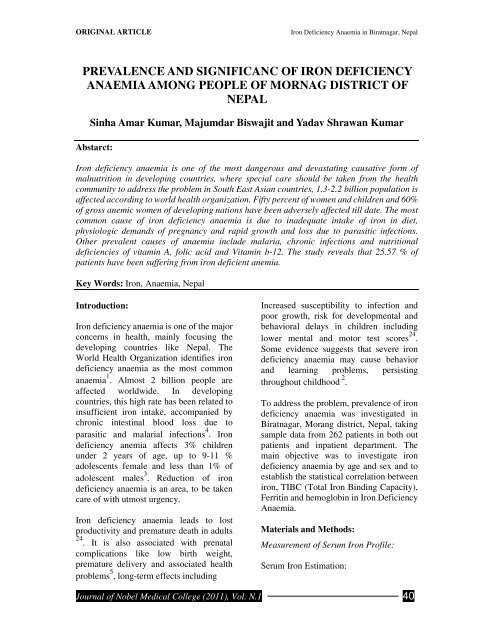Journal of - Nobel Medical College
Journal of - Nobel Medical College
Journal of - Nobel Medical College
You also want an ePaper? Increase the reach of your titles
YUMPU automatically turns print PDFs into web optimized ePapers that Google loves.
ORIGINAL ARTICLEIron Deficiency Anaemia in Biratnagar, NepalPREVALENCE AND SIGNIFICANC OF IRON DEFICIENCYANAEMIA AMONG PEOPLE OF MORNAG DISTRICT OFNEPALSinha Amar Kumar, Majumdar Biswajit and Yadav Shrawan KumarAbstarct:Iron deficiency anaemia is one <strong>of</strong> the most dangerous and devastating causative form <strong>of</strong>malnutrition in developing countries, where special care should be taken from the healthcommunity to address the problem in South East Asian countries, 1.3-2.2 billion population isaffected according to world health organization. Fifty percent <strong>of</strong> women and children and 60%<strong>of</strong> gross anemic women <strong>of</strong> developing nations have been adversely affected till date. The mostcommon cause <strong>of</strong> iron deficiency anaemia is due to inadequate intake <strong>of</strong> iron in diet,physiologic demands <strong>of</strong> pregnancy and rapid growth and loss due to parasitic infections.Other prevalent causes <strong>of</strong> anaemia include malaria, chronic infections and nutritionaldeficiencies <strong>of</strong> vitamin A, folic acid and Vitamin b-12. The study reveals that 25.57 % <strong>of</strong>patients have been suffering from iron deficient anemia.Key Words: Iron, Anaemia, NepalIntroduction:Iron deficiency anaemia is one <strong>of</strong> the majorconcerns in health, mainly focusing thedeveloping countries like Nepal. TheWorld Health Organization identifies irondeficiency anaemia as the most commonanaemia 1 . Almost 2 billion people areaffected worldwide. In developingcountries, this high rate has been related toinsufficient iron intake, accompanied bychronic intestinal blood loss due toparasitic and malarial infections 4 . Irondeficiency anemia affects 3% childrenunder 2 years <strong>of</strong> age, up to 9-11 %adolescents female and less than 1% <strong>of</strong>adolescent males 3 . Reduction <strong>of</strong> irondeficiency anaemia is an area, to be takencare <strong>of</strong> with utmost urgency.Iron deficiency anaemia leads to lostproductivity and premature death in adults24 . It is also associated with prenatalcomplications like low birth weight,premature delivery and associated healthproblems 5 , long-term effects includingIncreased susceptibility to infection andpoor growth, risk for developmental andbehavioral delays in children includinglower mental and motor test scores 24 .Some evidence suggests that severe irondeficiency anaemia may cause behaviorand learning problems, persistingthroughout childhood 2 .To address the problem, prevalence <strong>of</strong> irondeficiency anaemia was investigated inBiratnagar, Morang district, Nepal, takingsample data from 262 patients in both outpatients and inpatient department. Themain objective was to investigate irondeficiency anaemia by age and sex and toestablish the statistical correlation betweeniron, TIBC (Total Iron Binding Capacity),Ferritin and hemoglobin in Iron DeficiencyAnaemia.Materials and Methods:Measurement <strong>of</strong> Serum Iron Pr<strong>of</strong>ile:Serum Iron Estimation:<strong>Journal</strong> <strong>of</strong> <strong>Nobel</strong> <strong>Medical</strong> <strong>College</strong> (2011), Vol. N.1 40


